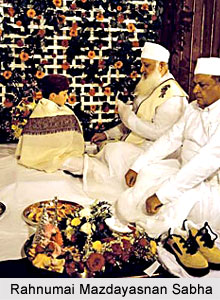 The Parsis were the refugee Zoroastrians from Iran. According to history, they reached Gujarat around 936 and gradually spread along the western Gujarat coast. They lived mainly in the ports and small towns of Gujarat. The Parsis evolved a system of socio-religious orders that was different to the caste system that existed among Gujarati Hindus. Due to their socio religious practice the Parsis faced many splits within their own community and during the first half of the nineteenth century; they were challenged by the Christian missionaries as well. At that point therefore uniting the entire community and establishing the superiority of Zoroastrianism over other religions became necessary and this led to the emergence of many Parsi socio-religious movements in India.
The Parsis were the refugee Zoroastrians from Iran. According to history, they reached Gujarat around 936 and gradually spread along the western Gujarat coast. They lived mainly in the ports and small towns of Gujarat. The Parsis evolved a system of socio-religious orders that was different to the caste system that existed among Gujarati Hindus. Due to their socio religious practice the Parsis faced many splits within their own community and during the first half of the nineteenth century; they were challenged by the Christian missionaries as well. At that point therefore uniting the entire community and establishing the superiority of Zoroastrianism over other religions became necessary and this led to the emergence of many Parsi socio-religious movements in India.
The first clash within the Parsi community occurred between two groups named Kadmi and Shahanshahis (royalists). The Kadmi was the group of people who followed the Iranian calendar and the Shahanshahis were those, who retained the calendar used in Gujarat. There was another division created within the Parsi community and this was related to the possession of wealth and assets of the Parsis. This division was created by the movement of Parsis in Bombay, many of whom were wealthy merchants, shipbuilders and commercial middlemen. This new prosperous group of Parsis regularly contrasted with the rural Parsis living in Gujarat.
With the increasing conflicts between the two groups of Parsis, the need of organising a council to oversee the community was felt very badly. The Parsi Panchayat was founded in 1728 for managing the internal affairs of the community. However it is the emergence of Rahnumai Mazdayasnan Sabha as a noteworthy organisation propelled the Parsi socio-religious movements in India, to a large extent. The movement started at a point of time when the Parsi community was being challenged by various forces. Its internal unity also became weak due to many reasons. The organisation was founded with an objective to find out solution for all the problems that the Parsi community was facing during that time. The organisation was also aimed at defending the cause of Zoroastrianism. Naoroji Furdunji was the founder of the Rahnumai Mazdayasnan Sabha. He first edited a journal named Fam-i-Famsbid, during the 1840s and also wrote many articles and books during the 1850s to prove the superiority of Zoroastrianism over Christianity.
Naoroji Furdunji and a few of his friends founded the Rahnumai Mazdayasnan Sabha (Parsis` Reform Society) in Bombay in 1851, to codify the Zoroastrian religion and reshape the Parsi social life. Furdunji became the president of the Sabha. K.N. Kama provided the necessary fund for establishing the Sabha. The secretary of the Sabha was Sorabji Shapurji Bengali. Achieving `the regeneration of the social condition of the Parsis and the restoration of the Zoroastrian religion in its pristine purity` were the broad objectives of the Rahnumai Mazdayasnan Sabha. The Sabha felt the necessity of fighting orthodoxy and to break through the numerous religious prejudices that tend to slow down progress and civilisation of the community. The Sabha strongly criticised the elaborate ceremonies at betrothals, marriages and funerals and also opposed both infant marriage and the use of astrology.
The Parsi socio-religious movements were aimed at defending the Zoroastrian religion from the challenges posed by various authorities and also to restore it in its pristine purity. Restructuring the Parsi society and introducing new cultural dimensions were also the other objectives of the Parsi socio-religious movements.



















